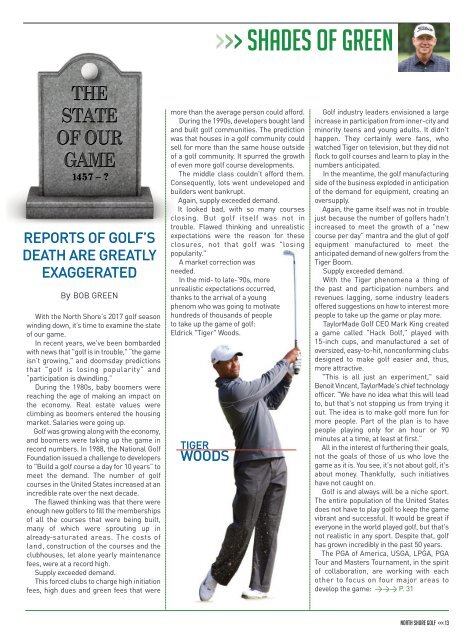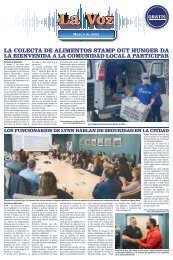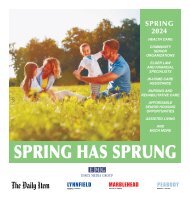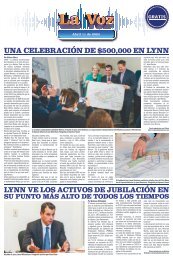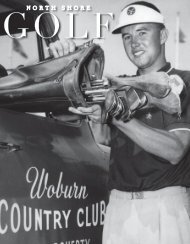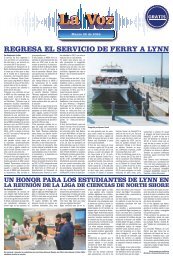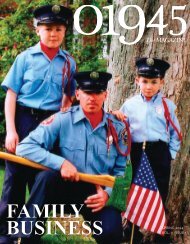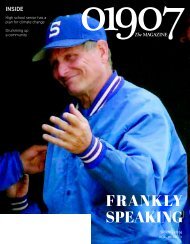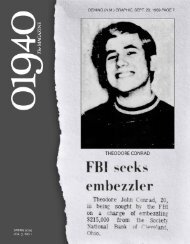Create successful ePaper yourself
Turn your PDF publications into a flip-book with our unique Google optimized e-Paper software.
SHADES OF GREEN<br />
THE<br />
STATE<br />
OF OUR<br />
GAME<br />
1457 – ?<br />
REPORTS OF GOLF’S<br />
DEATH ARE GREATLY<br />
EXAGGERATED<br />
By BOB GREEN<br />
With the North Shore's 2017 golf season<br />
winding down, it’s time to examine the state<br />
of our game.<br />
In recent years, we've been bombarded<br />
with news that "golf is in trouble," “the game<br />
isn’t growing," and doomsday predictions<br />
that "golf is losing popularity" and<br />
“participation is dwindling.”<br />
During the 1980s, baby boomers were<br />
reaching the age of making an impact on<br />
the economy. Real estate values were<br />
climbing as boomers entered the housing<br />
market. Salaries were going up.<br />
Golf was growing along with the economy,<br />
and boomers were taking up the game in<br />
record numbers. In 1988, the National Golf<br />
Foundation issued a challenge to developers<br />
to "Build a golf course a day for 10 years” to<br />
meet the demand. The number of golf<br />
courses in the United States increased at an<br />
incredible rate over the next decade.<br />
The flawed thinking was that there were<br />
enough new golfers to fill the memberships<br />
of all the courses that were being built,<br />
many of which were sprouting up in<br />
already-saturated areas. The costs of<br />
land, construction of the courses and the<br />
clubhouses, let alone yearly maintenance<br />
fees, were at a record high.<br />
Supply exceeded demand.<br />
This forced clubs to charge high initiation<br />
fees, high dues and green fees that were<br />
more than the average person could afford.<br />
During the 1990s, developers bought land<br />
and built golf communities. The prediction<br />
was that houses in a golf community could<br />
sell for more than the same house outside<br />
of a golf community. It spurred the growth<br />
of even more golf course developments.<br />
The middle class couldn't afford them.<br />
Consequently, lots went undeveloped and<br />
builders went bankrupt.<br />
Again, supply exceeded demand.<br />
It looked bad, with so many courses<br />
closing. But golf itself was not in<br />
trouble. Flawed thinking and unrealistic<br />
expectations were the reason for these<br />
closures, not that golf was "losing<br />
popularity."<br />
A market correction was<br />
needed.<br />
In the mid- to late-’90s, more<br />
unrealistic expectations occurred,<br />
thanks to the arrival of a young<br />
phenom who was going to motivate<br />
hundreds of thousands of people<br />
to take up the game of golf:<br />
Eldrick "Tiger" Woods.<br />
TIGER<br />
WOODS<br />
Golf industry leaders envisioned a large<br />
increase in participation from inner-city and<br />
minority teens and young adults. It didn't<br />
happen. They certainly were fans, who<br />
watched Tiger on television, but they did not<br />
flock to golf courses and learn to play in the<br />
numbers anticipated.<br />
In the meantime, the golf manufacturing<br />
side of the business exploded in anticipation<br />
of the demand for equipment, creating an<br />
oversupply.<br />
Again, the game itself was not in trouble<br />
just because the number of golfers hadn't<br />
increased to meet the growth of a "new<br />
course per day" mantra and the glut of golf<br />
equipment manufactured to meet the<br />
anticipated demand of new golfers from the<br />
Tiger Boom.<br />
Supply exceeded demand.<br />
With the Tiger phenomena a thing of<br />
the past and participation numbers and<br />
revenues lagging, some industry leaders<br />
offered suggestions on how to interest more<br />
people to take up the game or play more.<br />
TaylorMade Golf CEO Mark King created<br />
a game called "Hack Golf," played with<br />
15-inch cups, and manufactured a set of<br />
oversized, easy-to-hit, nonconforming clubs<br />
designed to make golf easier and, thus,<br />
more attractive.<br />
"This is all just an experiment," said<br />
Benoit Vincent, TaylorMade's chief technology<br />
officer. "We have no idea what this will lead<br />
to, but that's not stopping us from trying it<br />
out. The idea is to make golf more fun for<br />
more people. Part of the plan is to have<br />
people playing only for an hour or 90<br />
minutes at a time, at least at first.”<br />
All in the interest of furthering their goals,<br />
not the goals of those of us who love the<br />
game as it is. You see, it's not about golf, it's<br />
about money. Thankfully, such initiatives<br />
have not caught on.<br />
Golf is and always will be a niche sport.<br />
The entire population of the United States<br />
does not have to play golf to keep the game<br />
vibrant and successful. It would be great if<br />
everyone in the world played golf, but that's<br />
not realistic in any sport. Despite that, golf<br />
has grown incredibly in the past 50 years.<br />
The PGA of America, USGA, LPGA, PGA<br />
Tour and Masters Tournament, in the spirit<br />
of collaboration, are working with each<br />
other to focus on four major areas to<br />
develop the game: >>> P. 31<br />
NORTH SHORE GOLF


